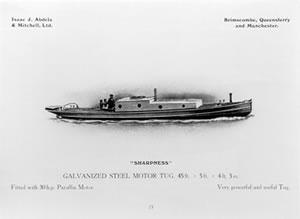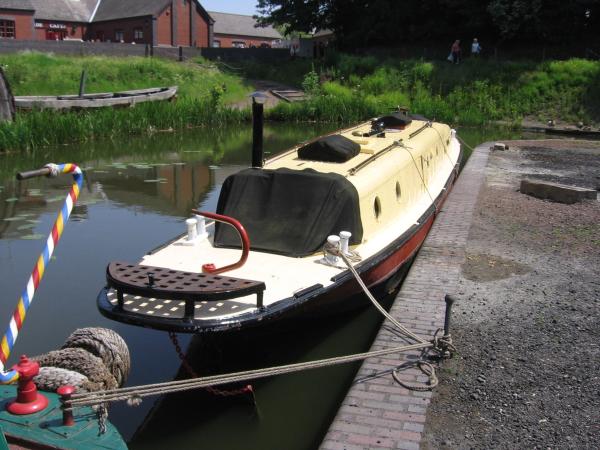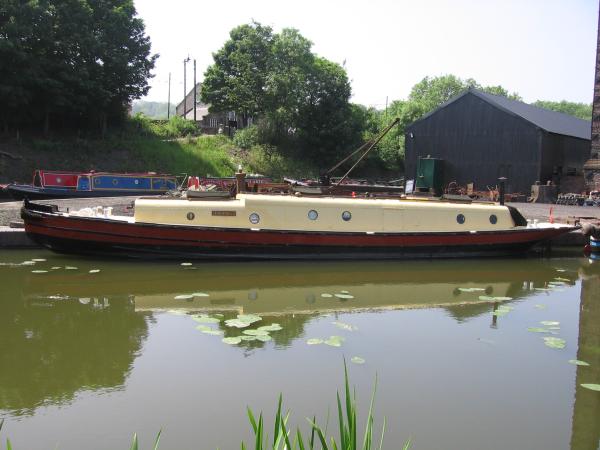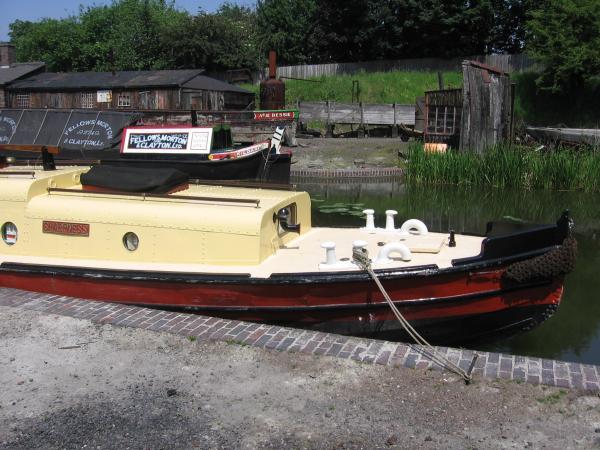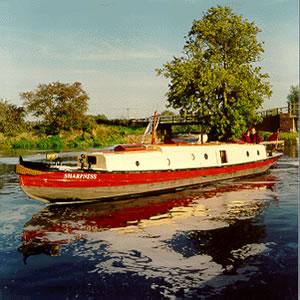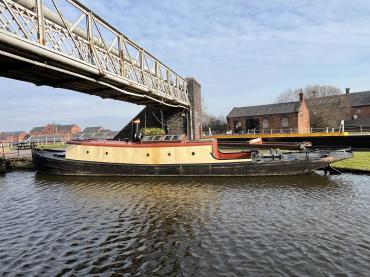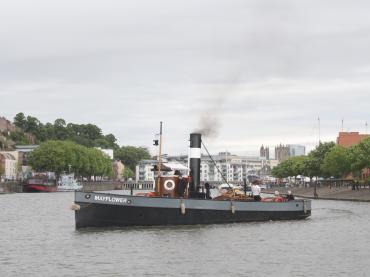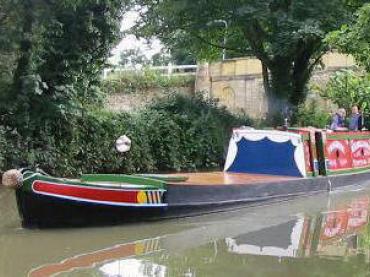

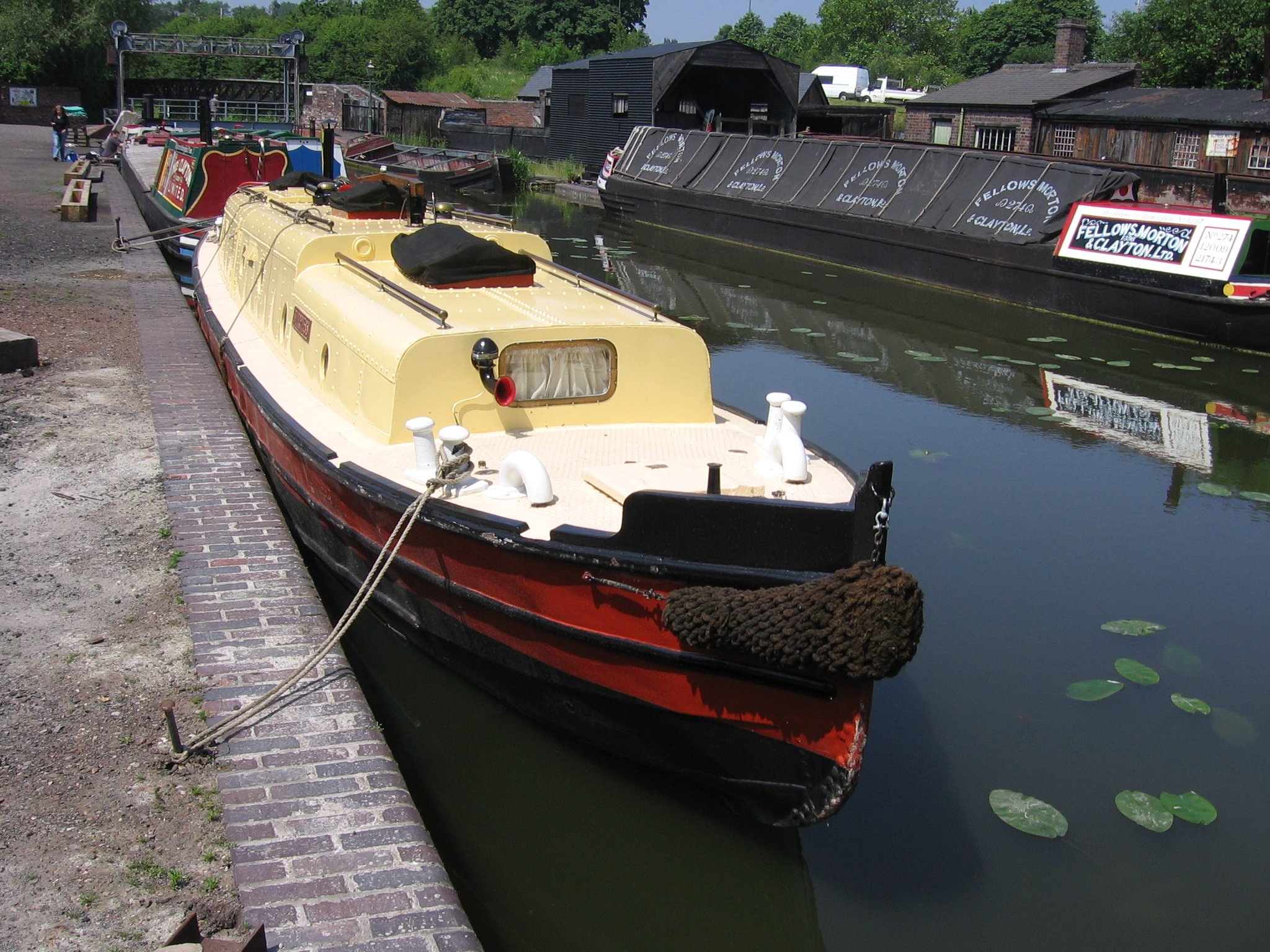
Details
Construction
Dimensions
History
SHARPNESS was built by Abdela & Mitchell of Brimscombe Port, Gloucester, as an ice-breaking tug, one of five motor tugs built between 1908 and 1912 for the Sharpness New Docks Company. She is a rare survivor (along with WORCESTER) of a pre-First World War canal tunnel tug.
SHARPNESS was built as an icebreaking tug in 1908 by Isaac J. Abdela and Mitchell, of Brimscombe Port, Stroud, on the Thames & Severn Canal. The builders were yacht and launch builders, and they gave SHARPNESS an elegant Edwardian style stern. She also has a raised bow for icebreaking.
Commissioned by the Sharpness New Docks Company, the Narrow Canal Tug SHARPNESS was to be one of three steam tugs based at Tardebigge. The other two tugs were the WORCESTER and the BIRMINGHAM, both built by the same builder.
SHARPNESS was mainly used as a tunnel tug and was soon transferred for duties on the Worcester and Birmingham Canal, where she spent all her working life. She was based at Tardebigge and Shortwood, where she was also used as an icebreaker, and worked as a tug to tow unpowered boats through Wast Hill tunnels including the Sapperton tunnel which connected the Severn and Thames Canal between 1908 and the 1960s.
SHARPNESSand her two sister tugs all had iron hulls; they were roughly 45 ft in length and had a width of just under 7 ft. Their petrol or paraffin engines were 30 horsepower, turning a four-bladed screw. SHARPNESS was one of the first internal-combustion-engined tugs.
As with larger vessels the motive power in canal craft evolved over the years. Narrowboats and barges were originally hauled by horses, or in some cases by men, and sometimes they even possessed sails. Although steam powered craft had been used on the Bridgewater Canal for many years previously, around the turn of the nineteenth and twentieth centuries they were also becoming popular on the Worcester and Birmingham Canal. Steam propulsion in narrowboats did not last long, and existing units were soon replaced by semi-diesel engines
She spent all her working life on the Worcester & Birmingham Canal until she was sold into private ownership by the British Waterways Board in the 1960s. She retained her external appearance and was seen at many Inland Waterways Association rallies in the 1960s and 70s. During the 1970s she had her cabin lengthened and lifted to give more headroom. At the same time more patches were added to her hull.
She was found for sale on the bank of the Kennet & Avon Canal in 1995, her hull and frames needing major repair. In recognition of their hard work the present owners received a Transport Trust Award in 1996. She originally had a single cylinder Petrol/Paraffin Kromhout 30 horsepower engine. This unfortunately suffered frost damage and was replaced by a lorry engine. Her current engine is a Gardner 4L2 engine built in 1932, 3 cy, bore 4 3/4 x stoke 7 1/4, producing 40 hp. The builder's plaque is not original.
Significance
1. What is the vessel’s ability to demonstrate history in her physical fabric?
Evidence for designs, functions, techniques, processes, styles, customs and habits or uses and associations in relation to events and people. How early, intact or rare these features are may impact on significance.
SHARPNESS was built in 1908 as an icebreaking tug. Her hull was constructed from 3/16 inch thick galvanized wrought iron plates riveted together, and she had wrought iron frames. She had a cruiser stern, and a raised reinforced bow for ice-breaking. She has a single deck and a single mast. She was originally powered by a single cylinder Petrol/Paraffin fired Kromhout 30 horsepower engine. This suffered frost damage and was replaced by a lorry engine. Her current engine is a 3 cylinders Gardner 4L2 engine built in 1932, with a bore of 4 3/4 and a stroke of 7 1/4, producing 40 hp. The builder's plaque is not original. During the 1970s SHARPNESS had her cabin lengthened and lifted to give more headroom, and more patches were added to her hull to strengthen her. By 1995 her frames and plating were in need of major repair, and a conservation programme was carried out between 1995 and 1998. The stern and most of the bow were replaced, together with many of the frames. The hull has been over-plated up to the bottom guard, and new plate has been inserted above the water line. Her hull and top were repainted in 2007.
2. What are the vessel’s associational links for which there is no physical evidence?
Associations with people or places. Off-ship research.
SHARPNESS was built in 1908 by Issac J. Abdela and Mitchell, of Brimscombe Port on the Thames and Severn Canal as an icebreaking tug. She has strong regional associations, having spent all her working life, from 1908 until the 1960s, on the Worcester & Birmingham Canal, mostly on the Tardebigge section as a tug towing unpowered boats through Wast Hill tunnels. In the 1960s SHARPNESS was sold into private ownership by the British Waterways Board. She retained her external appearance, and attended all the major rallies of the Inland Waterways Association in the 1960s and 1970s. In 1995 SHARPNESS was found on the bank of the Kennet and Avon Canal and sold to private owners. They received a Transport Trust Award in 1997 in support of the conservation programme. She has been recorded on the National Register of Historic Vessels since 1996 and is a member of the National Historic Fleet. Her national significance lies in the fact that she is the sole survivor of a small number of inland icebreaking tugs working on the canals. Her regional significance is the result of her associations with the Worcester and Birmingham Canal, the Kennet and Avon Canal and the Trent and Mersey Canal.
3. How does the vessel’s shape or form combine and contribute to her function?
Overall aesthetic impact of the vessel, her lines, material she was built from and her setting. Does she remain in her working environment?
The primary purpose of SHARPNESS was as a canal ice-breaker and this can be seen in the strength and construction method of her build. She is an unusually graceful vessel for her function, having an elegant Edwardian-style stern. This is a consequence of her having been designed and built by Abdela and Mitchell, who were yacht and launch builders. Nevertheless her shape, with her raised reinforced bow, meant that she was ideally fit for purpose as an ice-breaker. Since 2005 she has been moored at Dutton Stop on the Trent and Mersey Canal, where she remains in operational condition afloat in a setting very similar to those of her working life.
Source: NHS-UK team, 11 November 2015.
This statement was developed as part of the Heritage Lottery funded First World War project. http://www.ww1britainssurvivingvessels.org.uk/
Key dates
-
1908
Built by Mitchell, Isaac & Abdela of Brimscombe Port on the Thames & Severn Canal
-
1908-60s
Worked as a tug to tow unpowered boats through Wast Hill tunnels
-
1960s
Sold into private ownership by the British Waterways Board and attended all major rallies of the Inland Waterways Association
-
1970s
Cabin lengthened to give more headroom and patches added to strengthen the hull
-
1995
Sold to private owners
-
1995-98
Major restoration carried out
-
1997
Transport Restoration Award of £500
-
2005
Moored on the Trent & Mersey Canal, Dutton Stop
Grants
-
2007
A Sustainability Award of £2357 for the costs of a hull inspection was awarded from the Strategic Development Fund of National Historic Ships
Sources
Classic Boat Classic Boat Register of Endangered Boats, Poseidon Press
The Motor Boat: Canal Motor Transport, pp280, November 1909
Waterways World: Brinscombe Built Vessels 1902-1931, pp57, March 1978
Own this vessel?
If you are the owner of this vessel and would like to provide more details or updated information, please contact info@nationalhistoricships.org.uk

